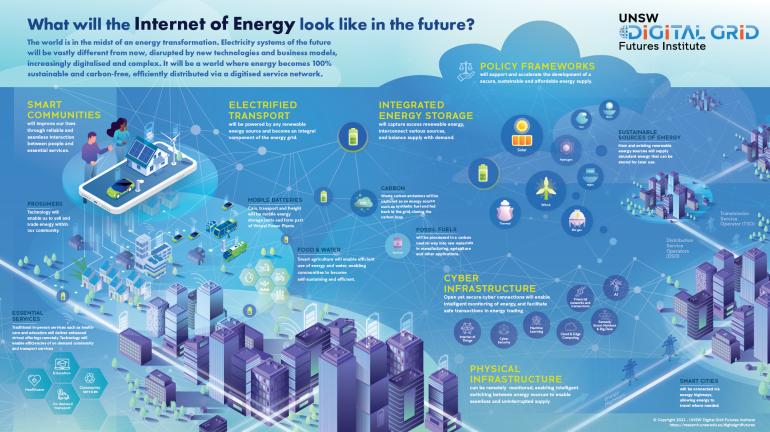NB: visit this link to view a high resolution version of the above infographic. (It may take some time for the text and images to load clearly on your screen)
This year, we will be sharing a series of monthly blog posts that aim to inspire thought and discussion around the opportunities presented by the future of energy. These will share our vision of what we can expect in the future of distributed energy sources, supplying abundant and carbon-free energy.
We will explore our research themes, and the crucial part each plays to ensure a transition that benefits all stakeholders in the energy sector. Finally, these will provide a taste of what life might be like for the next generation.
Please enjoy, and we encourage you to share!
Living with the internet of energy
A taste of what it will be like living in a smart community with decentralised, tradeable and hyperabundant energy.
(*All app and other brand names in this post are fictional, created for and intended for the purposes of this blog series only)
Michelle and Andrew recently bought a house in Sydney’s Parramatta.
Parramatta was one of the earlier adopters of Smart Community technology. Michelle and Andrew love the fact that energy for their EV, home and pool can be cost free most months with the use of the SmartEnergy app*, which connects smart meter owners to trade energy.
The app enables Michelle and Andrew to be prosumers without having to think about it, intelligently monitoring behaviours, the weather, electricity usage and generation capacity and trading surplus energy based on criteria they can control. As a result, Michelle and Andrew’s EV and home battery provide them with surplus energy most months that they can donate to charity or local communities they support.
Their local bus depot is one of many in Greater Sydney in which electric buses are managed autonomously. When the driver finishes their shift, they simply delegate control to the smart depot, which parks the bus, knowing its remaining charge, and ensures it is charged ready for its next deployment with an optimal charging strategy selected automatically by the smart charging system. The depot’s roof has such a large surface area, and together with the battery and surplus charge from the buses, it helps to supply local homes and small businesses through the SmartEnergy* app.
Michelle has also heard Parramatta is next on the list for Sydney’s new multi-modal transport network, where drones and underground robotics will take a lot of the delivery drivers off the roads, making for more parks and community hubs.
Being near the Parramatta River, Michelle also thinks her new solar to hydrogen battery pack will be able to connect to the ferry network battery to trade power, so her and Andrew can cash in energy credits to get free transport to the CBD when they need it.
Andrew’s father is at high risk of stroke, so their fully smart home has been a huge relief. Having 24/7 remote healthcare monitoring through the SmartHealth* app offers Andrew peace of mind. Andrew has permissions to access his dad’s medical status through the app, and the ‘virtual doctor’ lets him, and his local GP know if anything needs to be evaluated in person.
Andrew’s mother is good health, although she was recently diagnosed with type 2 diabetes, so the app also helps to monitor this with regular reminders to check her blood, providing her doctor and Andrew with instant results. The app has even added a new feature where volunteer care workers can upload their credentials including police checks, and can be called upon to make in-home care visits to elderly neighbours who might benefit from their experience.
Michelle works for a packaging company that supplies food manufacturers. Their products are 100% recyclable and are made in a carbon free factory – all of their carbon is converted into fuel, which helps to run the machinery and power the operation. They are solar and wind powered, and their large battery ensures that they are in surplus of energy – even in Sydney’s relentless summers.
Andrew works from home three days a week as a lecturer. He rarely needs to see his students in person now that telepresence is so good, but the teacher app his university uses means he’s just assigned students that live nearby, so it’s never more than an e-scooter ride to meet up somewhere.
He talks to quite a few of them outside class, as they have a power pooling group going to help their community aquaponic farm. The oceans are feeling the effects of climate change, so sustainable local farming has become more common.
Last year's bushfires in the Blue Mountains were contained quickly, but not before a solar farm was taken offline. It was a great feeling that Parramatta, along with neighbouring areas could transmit some of their energy to stand in for the farm's shortfall, meaning the energy supply was uninterrupted.
